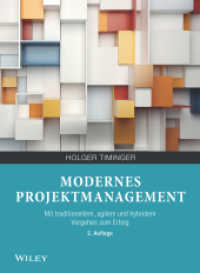Full Description
This book describes various aspects of the basic physiological processes critical to tissue perfusion and cellular oxygenation, including the roles of the circulatory system, respiratory system, blood flow distribution and microcirculation.
In the context of monitoring critically ill patients in the early hours of circulatory shock, it is essential to recognize changes in traditional parameters such as mean arterial pressure and cardiac output, and to assess the need for active intervention. However, even if global macrocirculatory variables are restored, abnormalities in tissue oxygenation may persist. Tissue hypoperfusion is connected to the development of organ failure and, if it goes unrecognized, may worsen the prognosis. As a result, there is a growing interest in methods for monitoring regional perfusion in peripheral tissues to predict or diagnose ongoing hypoperfusion.
In this work, eminent experts from a range of disciplines convey a working knowledge of how regional monitoring in shock can complement the conventional global parameters of oxygen transport, and demonstrate that real-time bedside assessment of tissue oxygenation is readily achievable using noninvasive monitoring techniques. Accordingly, the book offers a valuable, easy-to-use guide for the entire ICU team and other clinicians.
Contents
Part I. Introduction.- Chapter 1. Holistic Monitoring and Treatment of Septic Shock.- Part II. Principles of Oxygen Transport and Consumption.- Chapter 2. Oxygen Transport and Tissue Utilization.- Chapter 3. Guyton at the Bedside.- Chapter 4. Tissue Response to Hypoxia and its Clinical Relevance: Hypoxic Hypoxia, Circulatory Hypoxia, Anemic Hypoxia, Cytopathic Hypoxia.- Part III. Measuring Tissue perfusion: Systemic Assessment of Tissue Perfusion.- Chapter 5. Cardiac Function (Cardiac Output and its Determinants).- Chapter 6. Oxygen Transport Assessment.- Chapter 7. Central and Mixed Venous O2 Saturation: A Physiological Appraisal.- Chapter 8. Central Venous-to-Arterial Carbon dioxide Partial Pressure Difference.- Chapter 9. Lactate.- Part IV. Measuring Tissue perfusion: Regional Assessment of Tissue Perfusion.- Chapter 10. Clinical Assessment.- Chapter 11. Optical Monitoring.- Chapter 12. Trans cutaneous O2 and CO2 Monitoring.- Chapter 13. Regional Capnography.- Chapter 14.Clinical Implications of Monitoring Tissue Perfusion in Cardiogenic Shock.



![Mariusz Urbanski; Mario Roy; Sara Munday: Non-Invertible Dynamical Systems. Volume 1-3 [Set Non-Invertible Dynamical Systems, Vol 1-3], 2 Teile (De Gruyter Expositions in Mathematics) (2023. LXXXVI, 1336 S. 240 mm)](../images/goods/ar/work/imgdatak/31107/3110706792.jpg)




